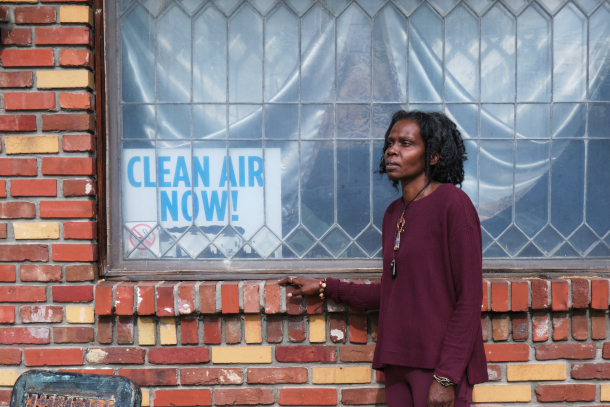Bad Air Polluting Our Brains
Air Date: Week of December 3, 2021

Melanie Meade has become the face of clean air advocacy in her town of Clairton, Pennsylvania, which sees high levels of both air pollution and mental illness. (Photo: Njaimeh Njie)
Air pollution causes serious damage to our bodies, sometimes resulting in premature death, and it’s also messing with our minds. Kristina Marusic is an investigative reporter with Environmental Health News, which published a 5-part series about how air, water, and climate pollution shape our mental health, and she joins Host Bobby Bascomb for the first part of our coverage of this series.
Transcript
CURWOOD: From PRX and the Jennifer and Ted Stanley Studios at the University of Massachusetts Boston, this is Living on Earth. I’m Steve Curwood.
BASCOMB: And I’m Bobby Bascomb.
Today we present a pair of new and disturbing reports that show some surprising and devastating health effects from pollution and synthetic chemicals. One of the recent studies reveals how a group of poorly regulated chemicals, often found in plastic, have strong links to chronic diseases including diabetes, obesity, and insulin resistance as well as behavioral disorders. We will have more on that later in the program. But first let’s consider the growing body of evidence linking air pollution to devastating effects on human health. In previous shows we’ve talked about scientists who have found a link between the tiny particulates from the exhaust of burning fossil fuels and roughly 300,000 excess deaths a year in the US, and millions more around the planet. Well, it also turns out that air pollution is literally messing with our minds. Investigative reporter Kristina Marusic has been digging into the connection between air pollution and mental health as part of a series on mental health and pollution for Environmental Health News. She focused her reporting on Western Pennsylvania, one of the worst regions in the country for air quality. Kristina Marusic, welcome back to Living on Earth!
MARUSIC: Hi, thanks so much for having me.
BASCOMB: Well, let's dig into some of the research that you were looking at for this article. Tell me about the 2019 study between the US and Denmark. What did they find?
MARUSIC: So, the 2019 study, you mentioned, looked at mental health data from 151 million people in the United States and 1.4 million people in Denmark. And they also looked at air pollution data, I spoke with one of the lead authors of that study and he mentioned that they had more detailed data for the Denmark group than they did for the American group. And the link between air pollution and mental illness for that group was even stronger. So, in just the people in Denmark, which again, was still a pretty big study, it was 1.4 million people across Denmark, they found that air pollution exposure was linked to a 31% increase in bipolar disorder, a 104% increase in schizophrenia, and a 210% increase in personality disorder and a 68% increase in major depression. So, the researcher I interviewed said he was personally really surprised by how strong the signal was, they did try to adjust for some of the other factors that could play a role in mental illness. So, things like parental education levels, employment status and income. So, they did try to you know, because the study didn't put people in a lab and expose them only to air pollution and then measure the results.

Children’s worsening mental health effects may be linked to small particulate matter air pollution, which comes from sources like the burning of diesel fuel. (Photo: Indiana Public Media, Flickr, CC BY-NC 2.0)
BASCOMB: You can't do that.
MARUSIC: Right, you can't do that ethically. So, you know, more research is certainly needed. But this was a big red flag for researchers that it certainly appears that exposure to air pollution can have a pretty substantial impact on our mental health.
BASCOMB: The study out of Denmark is pretty alarming, but it's not alone. You talked about another study out of the Cincinnati Children's Hospital that found a very clear link between spikes in air pollution, in this case, PM 2.5, and emergency room visits for children with mental health problems, what was going on there?
MARUSIC: So that study came out of Cincinnati Children's Hospital Medical Center and they looked at five years of emergency room data for more than 6,800 children under the age of 18 who visited the ER for psychiatric distress, including anxiety, depression, bipolar disorder, suicidality, personality disorders and schizophrenia. And they found that children who were exposed to high amounts of air pollution were significantly more likely to a few days later end up in the emergency room for a mental health problem than children with lower exposures were. Another thing that was really interesting about that study is that all the levels of air pollution exposure they looked at were below legal limits. So, they didn't exceed like the daily threshold for particulate matter pollution on any of those days where they saw a corresponding spike in ER visits. So that study is part of a growing body of research that indicates that air pollution exposures are harmful to human health at levels that are well below current legal limits.
BASCOMB: Wow. So, EPA says that this is our standard for air pollution and this is a safe level but that's not the case, at least when we're looking strictly at mental health problems associated with those exposures.
MARUSIC: Right, so EPA is currently considering lowering the threshold for particulate matter. They're expected to do that sometime in the next couple of years. And I would say in the last five years, scientists have started learning a lot more about these lower levels of pollution and how they're harmful so hopefully, regulations will start to catch up.
BASCOMB: And what do scientists think is the mechanism for air pollution to affect the mental health in this way?
MARUSIC: So, scientists are still trying to figure out exactly what happens in brains that are exposed to air pollution that affects mental health and cognition. But a lot of them think it's related to the inflammation that air pollution causes. So, we know that chronic inflammation in the brain can damage neurons that are involved in the brain and nervous systems, regulatory responses, which can impact mental health if you think about things like anxiety, that is you know, it's a lot more than just our brains that are involved in that process. Right, it's our whole body's ability to regulate and respond to challenging situations.
BASCOMB: Well, part of your article focuses on the work of an activist named Melanie Mead. Tell us a little bit about her story please.
MARUSIC: So, Melanie Mead lives in Clairton, which is a little bit south of Pittsburgh, still in Allegheny County, and Clairton really has some of the worst air pollution in the country. There's a huge industrial facility, there, it's US Steel's Clairton Coke Works and they convert coal into Coke for steelmaking. And that process involves heating coal to extremely high temperatures, which emits a lot of pollutants. The facility is regularly fined and regularly sued by both residents and environmental groups for violating clean air laws and sometimes failing to notify residents when there's a health hazard. Melanie has been a clean air advocate in Clairton for about eight years. She grew up there but moved away for a while and ended up moving back. And when she initially found out that kids in Clairton school districts have asthma rates that are more than double the national average, she was outraged, and she thought that everyone else would be too. Instead, she's really faced an uphill battle where she feels like, you know, a lot of her neighbors feel like it's just the way it's always been and we depend on jobs from the plants and, you know, there's kind of nothing we can do about it at this point. So, she has felt really disheartened, which, you know, is something that she said has negatively impacted her mental health. But she was also surprised to learn that air pollution can cause you know, physical changes in the brain that can impact mental health too. And she actually felt kind of validated learning that she said, you know, we have a lot of people in my community have mental health struggles. And then, you know, one thing that really struck me about her story was that when she was grieving the loss of both of her parents in a relatively short time period, she sought mental health services but she had to go across town to get them. And she said, you know, for a lot of people it's already hard enough to ask for help and then a lot of people here don't own cars, and public transportation is not reliable and so it's really just too many barriers to care. So, you know, she's really hopeful that areas that have high levels of pollution will also eventually get, you know, additional mental health resources.
BASCOMB: And to what degree is this an environmental justice issue? I mean, how likely is it that lower income and minority groups are disproportionately experiencing mental health challenges that can be traced back to this type of air pollution?

U.S. Steel Edgar Thompson Works in Braddock, PA. (Photo: Njaimeh Njie)
MARUSIC: So, air pollution travels, right. So, air pollution affects everybody who is in a geographic region that experiences high air pollution. So, in western Pennsylvania it certainly impacts all of us. But many of the communities that experienced the highest levels of pollution, and those frequent spikes of air pollution, like those ones that sent more kids to the emergency room, in the Cincinnati study, also experienced other community stressors like poverty, crime and racism. So, in the Cincinnati study that we talked about, they found that children from neighborhoods experiencing high levels of poverty were the most likely to experience a mental illness crisis following spikes in air pollution. And they hypothesize that this could be because poverty and living in a place with lots of crime also both cause stress, which also results in inflammation which can harm our brains and our immune systems, which could then worsen similar impacts from air pollution exposure. And there are examples of these kind of what some researchers call toxic zip codes across the US. And so those are regions where a combination of environmental injustice, racism and poverty creates substantial, overlapping negative mental health impacts. So, for example, the Monongahela Valley, which locally is referred to as the Mon Valley, is a collection of former steel towns bordering the Monongahela River between Pittsburgh and West Virginia and it's an area that regularly sees some extreme spikes in air pollution, leading to some of the dirtiest air in the country because it's a valley. So, pollutants tend to get trapped there, if there's a weather inversion, depending on wind patterns, that's where kind of all the pollutants in the region sink to and stay on a bad air day. And those municipalities in the Mon Valley, many of them are majority black and people of color communities and they also have poverty rates ranging from 16% to 40%, which is significantly higher than the national average of 13%. So historically, these communities ended up in these places they get stuck with higher pollution because of practices like redlining which restricted where people of color could live. And, you know, we know from general studies of environmental justice in the US that polluting facilities are much more likely to wind up in in low-income communities than they are in affluent communities. So, it really becomes an issue where all of these environmental exposures are kind of combining with other overlapping impacts to create a real impact on… on mental health in those areas.
BASCOMB: Now, what about other parts of the country? How common is it do you think that people might be suffering from mental health problems associated with air pollution and maybe not even aware of it?

Kristina Marusic is an investigative reporter with Environmental Health News. (Photo: Courtey of Kristina Marusic)
MARUSIC: So, there are a lot of places across the US where federal air pollution thresholds are exceeded on a pretty regular basis. We've come a really long way since the passage of the Clean Air Act and we've seen really vast improvement in health that's directly tied to that, but it's certainly not a problem we have solved. So, I mentioned, you know, some of those toxic zip codes that are in this region. And those exist across the country, every state you look in, you can find a zip code where they have more exposure to land and contaminants in the drinking water, and they also are exposed to higher levels of air pollutants. And for anyone who lives in an urban area this is a relevant question, we get more air pollution from traffic and from industrial processes. One thing I think is important to keep in mind is that on an individual level, air pollution certainly matters and can increase the likelihood that if you're already disposed to mental illness, being exposed to air pollution might kind of tip you over the edge but really all of these studies, the implication is at a population or community level. If we were able to stop a specific community that's exposed to really high levels of air pollution from being exposed to that air pollution, we could prevent many emergency room visits for mental illness, we could save lots of money in health care costs, you know, we would have more resources to allocate to communities that really need mental health services, because we would decrease the need for them. So, this is definitely a question that's, that's relevant for all of us in the US and especially for people who live in cities or near industrial polluters.
BASCOMB: Kristina Marusic is an investigative reporter with Environmental Health News. Kristina, thank you so much for taking the time with me today.
MARUSIC: Thank you so much for taking time to talk with me.
Links
Click to see the full 5-part series from Environmental Health News
Living on Earth wants to hear from you!
Living on Earth
62 Calef Highway, Suite 212
Lee, NH 03861
Telephone: 617-287-4121
E-mail: comments@loe.org
Newsletter [Click here]
Donate to Living on Earth!
Living on Earth is an independent media program and relies entirely on contributions from listeners and institutions supporting public service. Please donate now to preserve an independent environmental voice.
NewsletterLiving on Earth offers a weekly delivery of the show's rundown to your mailbox. Sign up for our newsletter today!
 Sailors For The Sea: Be the change you want to sea.
Sailors For The Sea: Be the change you want to sea.
 The Grantham Foundation for the Protection of the Environment: Committed to protecting and improving the health of the global environment.
The Grantham Foundation for the Protection of the Environment: Committed to protecting and improving the health of the global environment.
 Contribute to Living on Earth and receive, as our gift to you, an archival print of one of Mark Seth Lender's extraordinary wildlife photographs. Follow the link to see Mark's current collection of photographs.
Contribute to Living on Earth and receive, as our gift to you, an archival print of one of Mark Seth Lender's extraordinary wildlife photographs. Follow the link to see Mark's current collection of photographs.
 Buy a signed copy of Mark Seth Lender's book Smeagull the Seagull & support Living on Earth
Buy a signed copy of Mark Seth Lender's book Smeagull the Seagull & support Living on Earth

